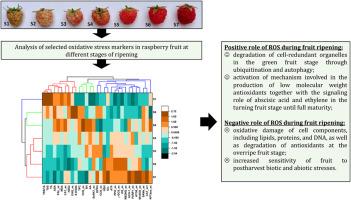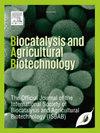树莓(Rubus idaeus L.)果实成熟过程中氧化还原状态的变化
IF 3.4
Q2 BIOTECHNOLOGY & APPLIED MICROBIOLOGY
引用次数: 0
摘要
了解影响浆果果实成熟过程的机理非常重要,这不仅能正确确定果实最适口、货架期最稳定的适当采收日期,还能在采收前制定调节成熟过程的新策略。人们认识到,浆果果实的质量及其收获后的货架期取决于细胞的氧化还原平衡。因此,我们决定对覆盆子果实从青果到过熟果不同成熟阶段的氧化应激状态水平进行全面分析。我们既评估了典型氧化应激标志物的水平,即 ROS 的产生、抗氧化酶的表达、细胞损伤程度,也评估了参与能量、谷胱甘肽和多酚代谢的特定蛋白质的表达。我们发现 ROS 的产生有两个阶段性高峰。第一个是在绿色果实中,这与抗氧化酶(MnSOD、CAT)、PARP-1 以及与谷胱甘肽生物合成(GS、γ-GC)、自噬(ATG-8)和泛素化(UBQ-11)相关的蛋白质的最大表达量相对应。其次,在过熟的果实中,细胞成分(即脂质、蛋白质和 DNA)的氧化修饰加剧,低分子量抗氧化剂流失。果实成熟过程则表现为参与多酚生物合成(PAL、CHS)、细胞呼吸(ACO-1、Cyt-C-ox、ATPase)、乙烯生物合成和信号传递(SAMs、EIN-2)的蛋白质表达量大幅增加,以及 ABA 含量增加。本文章由计算机程序翻译,如有差异,请以英文原文为准。

Changes in redox status in raspberry (Rubus idaeus L.) fruit during ripening
The knowledge of the mechanisms affecting the process of berry fruit ripening is important, not only to correctly determine the appropriate date of harvest, at which the fruit is most palatable and characterized by adequate shelf-life stability, but also, to develop new strategies of regulating the ripening process before harvesting. It is recognized that berry fruit quality and its post-harvest shelf-life depend on the cellular redox homeostasis. We, therefore, decided to conduct a comprehensive analysis of the level of oxidative stress status in the raspberry fruit proper at different stages of fruit ripening, from green to overripe fruit. We assessed both the level of typical oxidative stress markers, i.e. ROS production, expression of antioxidant enzymes, degree of cell damage, as well as the expression of selected proteins involved in the energy, glutathione, and polyphenols metabolism. We found two stage-related peaks of ROS production. The first - in green fruit, which corresponded to the maximum expression of antioxidant enzymes (MnSOD, CAT), PARP-1, as well as proteins related to glutathione biosynthesis (GS, γ-GC), autophagy (ATG-8) and ubiquitination (UBQ-11). The second one, in the overripe fruit, was responsible for the intensification of oxidative modifications of cell components, i.e. lipids, proteins, and DNA, as well as the loss of low molecular-weight antioxidants. The fruit ripening process, in turn, was manifested by a strong increase in the expression of proteins involved in the biosynthesis of polyphenols (PAL, CHS), cellular respiration (ACO-1, Cyt-C-ox, ATPase), ethylene biosynthesis and signaling (SAMs, EIN-2) and increasing amounts of ABA.
求助全文
通过发布文献求助,成功后即可免费获取论文全文。
去求助
来源期刊

Biocatalysis and agricultural biotechnology
Agricultural and Biological Sciences-Agronomy and Crop Science
CiteScore
7.70
自引率
2.50%
发文量
308
审稿时长
48 days
期刊介绍:
Biocatalysis and Agricultural Biotechnology is the official journal of the International Society of Biocatalysis and Agricultural Biotechnology (ISBAB). The journal publishes high quality articles especially in the science and technology of biocatalysis, bioprocesses, agricultural biotechnology, biomedical biotechnology, and, if appropriate, from other related areas of biotechnology. The journal will publish peer-reviewed basic and applied research papers, authoritative reviews, and feature articles. The scope of the journal encompasses the research, industrial, and commercial aspects of biotechnology, including the areas of: biocatalysis; bioprocesses; food and agriculture; genetic engineering; molecular biology; healthcare and pharmaceuticals; biofuels; genomics; nanotechnology; environment and biodiversity; and bioremediation.
 求助内容:
求助内容: 应助结果提醒方式:
应助结果提醒方式:


